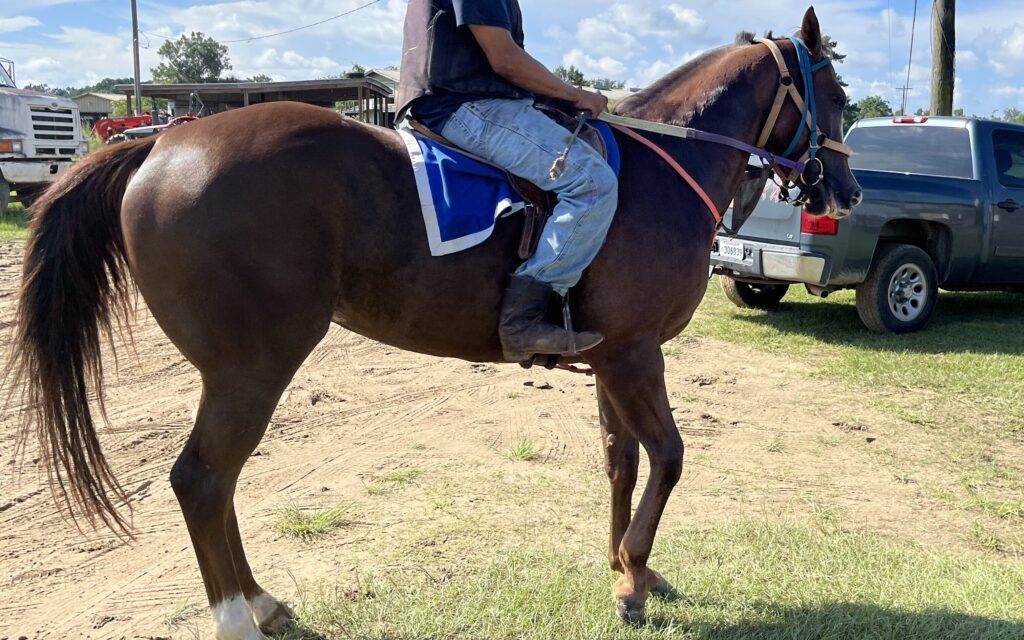Last updated: February 8, 2025
Have you ever wondered how much weight a horse can safely carry? It’s a question that many horse owners and riders need to know.
Equine experts generally agree that a horse can comfortably carry about 20% of its body weight, including the rider and equipment. But is this 20% rule set in stone? While it’s a good starting point, a horse’s carrying capacity depends on many factors.
With over 25 years of experience working with racehorses, I’ve witnessed the effects of excessive weight on horses. This experience, combined with reliable research, has led me to provide an answer you can trust.
This guide explores factors influencing a horse’s weight-carrying capacity, such as breed, fitness, and conformation, to promote the well-being of our equine partners. Let’s ensure safe and enjoyable riding experiences for both you and your horse.

Understanding the 20% Rule for Horse Weight-Carrying Capacity
Equine experts agree that a horse can comfortably carry about 20% of its body weight, including the rider and equipment. For instance, a 1,000-pound horse can safely carry approximately 200 pounds. This aligns with research and historical guidelines, such as the U.S. Cavalry Manuals of Horse Management from 1920.
Scientific Research and Historical Guidelines Supporting the 20% Rule for Horse Weight
Scientific studies support this guideline. A 2008 study conducted by Ohio State University evaluated horses carrying 15%, 20%, 25%, and 30% of their body weight, monitoring heart rate, plasma lactate concentration, and muscle soreness. At 25% body weight, horses exhibited increased heart rates and muscle discomfort, which intensified at 30% with notable changes in blood lactate levels. The study suggests that carrying up to 20% of a horse’s body weight is generally safe.
While the 20% guideline is a useful general rule, individual horse characteristics, such as breed, age, health, and fitness, influence weight-carrying capacity. For example, Icelandic Horses are compact with thicker cannon bones, allowing them to carry between 20% and 35% of their weight. However, studies show they work most efficiently up to 23%, beyond which they begin to show aerobic fatigue.
Arabian Horses, commonly used in endurance racing, tend to suffer higher rates of lameness if their cannon bones are too small, reinforcing the importance of conformation in weight carrying.
A well-conditioned horse might manage slightly more than 20%, while others should carry less. By adhering to these guidelines and considering your horse’s unique attributes, you can ensure safe and enjoyable riding experiences for both you and your equine partner.
For a more in-depth understanding, you might find this YouTube video helpful:
Key Factors Influencing a Horse’s Weight-Carrying Capacity
Several key factors determine how much weight a horse can comfortably carry. Understanding these variables helps owners ensure optimal performance and longevity for their horses.
- Age: Young horses haven’t reached full muscular and skeletal maturity, limiting their weight-carrying capacity. Older horses may experience reduced muscle mass and joint wear, affecting their ability to support heavier loads. (University of Minnesota Extension on Equine Growth)
- Health: A horse in peak health naturally has greater strength and endurance. Proper veterinary care, including regular checkups, vaccinations, and prompt treatment of injuries, is essential to maintain muscle and joint health. (AAEP Equine Health Guidelines)
- Breed: Draft horse breeds, such as Clydesdales and Shires, are built for strength and endurance, making them suitable for carrying heavier loads. Lighter breeds, like Arabians and Thoroughbreds, are optimized for speed and agility, often having lower weight-carrying capacities. For a deeper understanding of how different horse breeds compare in strength, explore this guide to choosing the right horse breed.
- Nutrition: A nutrient-rich diet is crucial for muscle development and bone health. Deficiencies in protein, vitamins, and minerals can weaken bones and muscles, reducing a horse’s strength. If you’re wondering what an ideal diet looks like, check out this guide on what horses eat.
- Conformation: Horses with broad loins and thick cannon bones can support more weight with less strain. In contrast, horses with long legs and weak backs have lower carrying capacities. A horse’s average weight is also a useful indicator of its ability to bear loads. Learn more about how a horse’s weight influences its carrying capacity.
- Fitness: A fit horse can better lift its back and support the rider’s weight while maintaining balance and endurance. Regular conditioning exercises improve muscular strength and stamina, allowing a horse to carry slightly more weight comfortably. (Oklahoma State University on Conditioning Horses)
- Rider’s Fitness and Expertise: A balanced, experienced rider helps distribute weight evenly, minimizing strain on the horse. Unfit or unbalanced riders can shift weight unpredictably, making it harder for the horse to maintain stability and comfort. (Being a Fit Rider Can Help Your Horse)
- Type of Activity & Terrain: Rough terrain, long distances, and high speeds place additional stress on a horse’s body. A horse that carries heavier loads over long distances may need frequent rest and conditioning. If you’re planning long rides, check out how far a horse can travel in a day.
- Hoof Care: Proper hoof care is critical for even weight distribution and soundness. Untrimmed or imbalanced hooves can misalign weight distribution, leading to lameness and discomfort. Regular farrier visits and proper hoof maintenance improve a horse’s ability to carry weight safely. Learn more about horse hoof care, anatomy, and maintenance.
- Riding Gear: A well-fitted saddle ensures even weight distribution, preventing pressure points and soreness. A poorly fitted saddle can cause discomfort and lead to compensatory movement issues, affecting a horse’s strength and performance. (Tack Fit and Use)

Equine Anatomy and Strength: Impact on Weight-Carrying Capacity
A horse’s ability to carry weight is deeply influenced by its anatomical structure, particularly the skeletal and muscular systems.
Skeletal System: The equine skeleton comprises approximately 205 bones, forming a framework that supports the horse’s body and facilitates movement. Notably, horses lack a collarbone; instead, their forelimbs are attached to the spinal column by a powerful set of muscles, tendons, and ligaments, allowing for enhanced flexibility and strength.
The spine’s unique design offers both support and flexibility, essential for various activities.You can learn more Essential Anatomy for Understanding Horse Musculoskeletal Health
Muscular System: Working in tandem with the skeleton, the muscular system enables movement and maintains posture. Key muscle groups, especially those in the hindquarters, generate propulsion, while muscles along the back and neck play vital roles in balance and weight-bearing. The limbs, composed of bones, joints, muscles, tendons, and ligaments, support the horse’s weight and are crucial for movement.
A horse’s physical build plays a key role in its ability to carry weight. Research indicates that horses with wider loins and thicker cannon bones show less muscle soreness after carrying heavier loads.
While horses possess considerable strength, it’s crucial to recognize their limitations. A study published in the Journal of Equine Veterinary Science evaluated eight horses carrying 15%, 20%, 25%, and 30% of their body weight in separate trials. Researchers monitored heart rate, muscle enzymes, blood lactate levels, muscle soreness, and stiffness.
The findings revealed that at 25% of their body weight, horses exhibited increased heart rates and muscle discomfort. These effects intensified at 30%, with notable changes in blood lactate levels. Consequently, the study suggests that carrying up to 20% of a horse’s body weight is generally safe. However, individual factors such as conformation can influence a horse’s carrying capacity.
By understanding and respecting the equine musculoskeletal system, you can optimize your horse’s health, prevent injuries, and improve performance. For further insights, read How Strong Is A Horse? Let’s Look At Their Power! and share your thoughts in the comments!

Balancing Rider Weight, Equipment, and the Horse’s Own Weight
Ensuring a horse’s comfort and health involves careful consideration of weight distribution, appropriate equipment, and the horse’s physical condition.
- Saddle Fit: A well-fitted saddle is crucial for distributing the rider’s weight evenly across the horse’s back. Poorly fitted saddles can create pressure points, leading to discomfort or injury. Important Elements of Saddle Fit Veterinarians Should Know
- Rider Balance: Maintaining a balanced riding position enhances communication with your horse and promotes better performance. An unbalanced rider can inadvertently cause uneven weight distribution, leading to potential discomfort for the horse. Saddle Fit and Asymmetry (Crookedness – Both Horse and Rider)
- Horse’s Physical Condition: A well-conditioned horse can support weight more efficiently. Regular exercise and proper nutrition contribute to muscle development and overall fitness, enhancing the horse’s ability to carry weight. For insights on improving your horse’s fitness, consider reading our article on horse conditioning to take off excess weight and get fit.
By focusing on these aspects, riders can ensure a more comfortable and effective partnership with their horses.

Breed Variation in Weight-Carrying Ability
Different horse breeds have varying capacities for carrying weight:
- Draft Breeds (e.g., Clydesdales, Shires): Known for their strength, these breeds can carry heavier loads due to their substantial build and muscle mass. For more information on draft breed check out, The Largest Horse Breeds in the World.
- Agile Breeds (e.g., Arabians, Mustangs): These breeds excel in activities requiring agility and speed but may have lower weight-carrying capacities compared to draft breeds.
- Thoroughbreds: Bred primarily for racing, Thoroughbreds are built for speed and may not be ideal for carrying substantial weight. Learn why racehorses carry different weights.
- Gaited Breeds (e.g., Paso Fino): Some gaited breeds can carry more than 20% of their body weight, depending on their build and conditioning.
- Mules: Known for their robustness, mules can often carry up to 25% of their body weight, making them suitable for carrying heavier loads.
Understanding these variations is crucial for ensuring the well-being of the horse and preventing potential injuries associated with overloading.

The Impact of Weight on Horse Metabolism and Nutritional Needs
When a horse’s workload increases, either through heightened activity or by carrying additional weight, its metabolic rate rises to meet the enhanced energy demands. This escalation necessitates adjustments in the horse’s nutritional intake to maintain optimal health and performance.
Energy Requirements: Elevated workloads amplify a horse’s energy needs. To accommodate this, incorporating energy-dense feeds such as grains or fat supplements can be beneficial. However, it’s crucial to balance these additions to prevent digestive disturbances. Characterizing the Exercise Workloads and Energy Needs of Horses
Protein and Amino Acids: Exercise increases the horse’s protein and lysine requirements, essential for muscle repair and development. Ensuring adequate intake supports recovery and promotes muscle health. Feeding Performance Horses: Nutrition for Peak Performance
Hydration: With increased activity, water requirements rise due to greater losses through sweat. Maintaining access to clean, fresh water is vital for thermoregulation and overall metabolic function. Nutritional Requirements of Horses and Other Equids
Monitoring and Adjustments: Regular assessment of the horse’s body condition and performance can guide dietary modifications. Adjusting feed types and quantities ensures that the horse’s energy and nutrient needs are met without leading to overconditioning or underconditioning. Feed requirements of horses
By attentively managing these nutritional aspects, owners can support their horses in meeting the physical demands of increased workloads, thereby promoting health, performance, and longevity.

Choosing a Horse: Matching Weight, Size and Abilities for Rider and Horse
Selecting the appropriate horse involves a thorough understanding of both your requirements and the horse’s capabilities. Key considerations include:
- Your Weight: Accurately assess your body weight to ensure compatibility with the horse’s carrying capacity. Choosing a riding horse
- Equipment Weight: Factor in the weight of all riding gear, including the saddle, bridle, and any additional equipment, as this contributes to the total load the horse will bear.
Smaller Horses
Benefits: Smaller horses often offer greater agility, are easier to mount and handle, may require less feed, and can be more manageable for certain riders.
When to Choose: If your combined weight (including equipment) falls within the safe carrying capacity of a smaller breed, and you prioritize agility over strength, a smaller horse may be suitable.
Larger Horses
Benefits: Larger horses can carry more weight, have a longer stride, and often possess a majestic presence.
When to Choose: If your combined weight (including equipment) approaches the upper limit of a smaller horse’s capacity, or if you require more power for specific activities, a larger horse may be more suitable.
By carefully evaluating these factors, you can select a horse that aligns with your physical characteristics and riding objectives, ensuring a harmonious and effective partnership. Finding Your First Horse: A Complete Guide
Below is a YouTube video explaining how much weight a horse should carry.
Why Knowing a Horse’s Carry Capacity is Important
Understanding a horse’s carrying capacity is crucial for maintaining its health and overall welfare. Overburdening a horse can lead to serious health issues, including lameness, back pain, balance problems, sore muscles, and chronic joint issues.
Historically, horses were essential for transportation, but even in modern times, it’s important to ensure horses are not overloaded. Overloading can lead to lameness, back pains, balance issues, sore muscles, temperament issues, and chronic pain and joint problems.
Many riding establishments implement specific weight policies to protect their horses. For instance, Circle F Dude Ranch Camp enforces a weight limit of 250 pounds for riders, emphasizing that exceeding this limit can be detrimental to the horse’s well-being.
By understanding and respecting a horse’s carrying capacity, owners and riders can make informed decisions regarding appropriate riding gear and effective exercise routines, thereby promoting the horse’s long-term health and performance.

Frequently Asked Questions About Horse Carry Weight Limits
If you still have questions after reading this article, check out these commonly asked questions.
What factors influence a horse’s ability to carry weight?
A horse’s weight-carrying capacity is influenced by several factors, including its conformation (body structure), fitness level, age, and the type of activity it performs. Horses with a short, well-muscled back and thick cannon bones are generally better suited to carry heavier loads. Additionally, a well-conditioned horse with balanced musculature can support weight more efficiently.
How can I determine if my horse is carrying too much weight?
Signs that a horse may be overburdened include increased heart rate, rapid breathing, muscle soreness, and fatigue during or after exercise. Monitoring your horse’s performance and recovery can help identify if it’s carrying too much weight. Regular veterinary check-ups can also provide insights into your horse’s physical condition and weight-carrying capacity.
Are there specific breeds known for better weight-carrying abilities?
Yes, certain breeds are recognized for their superior weight-carrying capabilities. For instance, Icelandic horses, despite their smaller stature, are known to carry between 20% and 35% of their body weight due to their compact build and thicker cannon bones. Similarly, some gaited breeds like the Paso Fino can carry more than 20% of their weight.
Does the type of saddle affect a horse’s ability to carry weight?
Absolutely. A well-fitted saddle is crucial for distributing the rider’s weight evenly across the horse’s back, preventing pressure points and discomfort. Conversely, a poorly fitted saddle can create uneven weight distribution, leading to muscle soreness and potential injury. Ensuring proper saddle fit is essential for your horse’s comfort and health.
How does terrain impact a horse’s weight-carrying capacity?
The type of terrain significantly affects a horse’s ability to carry weight. Navigating rough, uneven, or steep terrain requires more effort and energy from the horse, effectively reducing its weight-carrying capacity compared to traveling on flat, even surfaces. When planning rides over challenging terrain, it’s important to consider reducing the load to prevent overexertion.
Conclusion: Prioritizing Horse Well-Being Through Understanding Carrying Capacity
Understanding and respecting a horse’s carrying capacity is a cornerstone of responsible ownership. It’s not just about how much weight a horse can carry but also about how that weight is managed. By adhering to these guidelines, riders promote their horse’s health and strengthen their bond with them. Prioritizing the well-being of the horse is a fundamental responsibility for every rider.
To ensure your horse’s health and happiness, assess your horse’s carrying capacity today and make any necessary adjustments to your riding practices. Your horse’s well-being depends on it.
Share your experiences and insights on managing your horse’s carrying capacity. Your stories can help fellow riders make informed decisions and foster a community dedicated to equine welfare.

About the Author: Miles Henry
Lifelong Horseman | Racehorse Owner | Published Author
Miles Henry brings over 25 years of hands-on experience training and owning Thoroughbred racehorses. Raised with Quarter Horses and Appaloosas, he’s spent a lifetime learning from horses—on the track, in the barn, and in the field. Today, he runs a small but successful racing stable in Louisiana and shares real-world insights on HorseRacingSense.com, helping horse owners, fans, and bettors navigate the sport with confidence.
📚 Books: View Miles’s books on Amazon »
🎧 Podcast Guest: Animal Tales Ep. 32 |
YouTube Interview
📩 Newsletter: Sign up for racing tips and horse care advice »
🔗 Follow Miles:
Twitter |
Facebook |
YouTube



